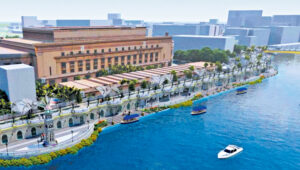Revitalizing a significant stream towards a more developed Metro Manila

The Pasig River depicted in Jose Rizal’s novels from the 1800s with trees and clean water is very different from the one people see at present.
The 27-kilometer stream flowing from Laguna de Bay through the National Capital Region and then into Manila Bay was declared biologically dead in the 1990s. This is why the Philippine government launched several rehabilitation initiatives throughout the years to clean up and salvage Manila’s iconic waterway.
Through the Pasig River Rehabilitation Commission, instituted in 1999 and abolished in 2018, along with advocates and private institutions, the river once again started showing signs of life with thriving biodiversity and vegetation, and an operating ferry system that passengers can ride for free.
To further the growth and revival of the Pasig River, President Ferdinand “Bongbong” Marcos, Jr. issued Executive Order No. 35 constituting the Inter-Agency Council for the Pasig River Urban Development (IAC-PRUD) chaired by Department of Human Settlements and Urban Development (DHSUD) Secretary Jose Rizalino L. Acuzar.
“The issuance of Executive Order 35 is like hitting many birds with one stone. It will trigger huge positive impacts to several sectors like housing, transportation, and even tourism,” Mr. Acuzar was quoted as saying in the department’s website.
The IAC-PRUD is mandated to rehabilitate the banks along the river with the end view of maximizing its full potential in the areas of tourism, recreation, transportation, and sustainable human settlement. The interagency council presented its master plan to Malacañang dubbed as Pasig Bigyang Buhay Muli (PBBM) Project in August last year.
The DHSUD and the council aim to create commercial hubs and public parks in strategic locations on the 27-kilometer stretch of the river. They also identified eight key areas where people-centric improvements as well as recreational and wellness centers can be constructed. Along with these projects, the DHSUD is also eyeing the creation of jogging paths and bike lanes that traverse all the major cities from Metro Manila to Rizal.
The relocation of informal settler families (ISFs), which is included in the IAC-PRUD’s masterplan to improve quality of life, will be undertaken as part of the flagship Pambansang Pabahay Para sa Pilipino Program being implemented also by the DHSUD.
These resettlements will be done in collaboration with other national government agencies like the Philippine Ports Authority (PPA), the Philippine Coast Guard (PCG), and the Laguna Lake Development Authority (LLDA).
There are already two proposed major housing projects for ISF that will be affected by the rehabilitation of the river: the first one, in collaboration with the PPA, will be in Manila; and the second will be at Lupang Arenda in Rizal with help from the LLDA.
Recently, the DHSUD unveiled the first phase of the PBBM project, merely six months after inspecting the area and getting approval for the master plan. On Jan. 18, Mr. Acuzar along with President Marcos and First Lady Liza Araneta-Marcos inaugurated the showcase area of the Pasig River urban development project in Manila.
Spanning almost 500 meters behind the Manila Central Post Office building, the newly constructed Pasig River site will serve as a public park complete with a water fountain accented by lighting, sitting areas that can also serve as an open-air venue for events, and a pedestrian-friendly walkway.
The showcase area is highlighted by a transition bridge under the Jones Bridge that will ensure seamless connectivity from Manila Bay’s north harbor to Laguna de Bay. The once-dark and neglected bank of the Pasig River has been illuminated by the installation of vintage Victorian lamp posts and statues.
“This is not just a beautification project; we intend to implement functional development along the Pasig River that will promote tourism and transportation connectivity for the benefit of ordinary Filipinos. This is only the first phase, you can rely on us to progress in this project,” Mr. Acuzar said in mixed English and Filipino during his speech at the inauguration of the new river park.
Eight other showcase areas, similar to the one in Manila, will be built along key areas of the Pasig River “to provide people with the ideal environment to enjoy a day or evening with their family or friends in a well-lit open-space, park-like setting,” Mr. Acuzar added.
The PBBM project is estimated to be completed between 2027 and 2029 and will be funded through private donations.
Other members of the IAC-PRUD include the secretaries of the Department of Public Works and Highways, the Department of Environment and Natural Resources, the Department of Interior and Local Government, the Department of Transportation, the Department of Tourism, the Department of Finance, and the Department of Budget and Management; the chairpersons of the National Historical Commission of the Philippines and the National Commission for Culture and the Arts; the general manager of the PPA and the LLDA; the commandant of the PCG; and the chief executive officer of the Tourism Infrastructure and Enterprise Zone Authority; with the National Housing Authority serving as the secretariat. — Jomarc Angelo M. Corpuz




